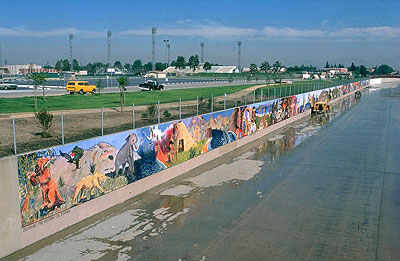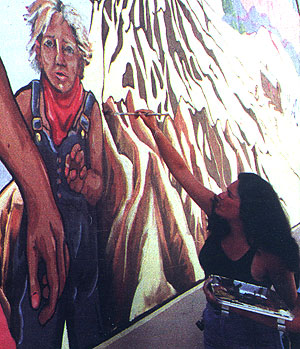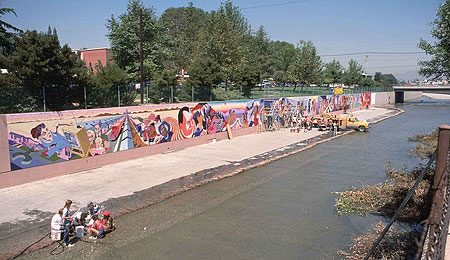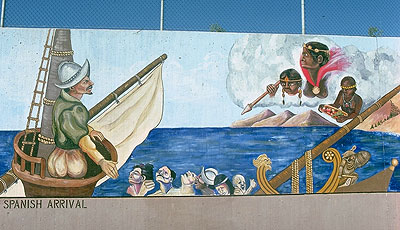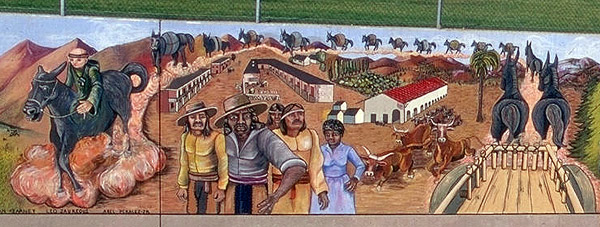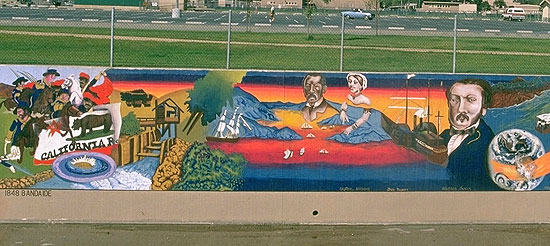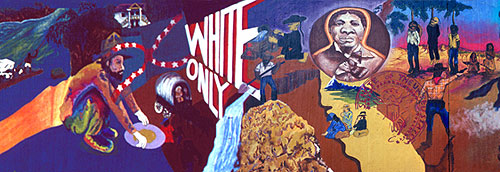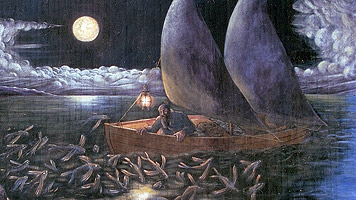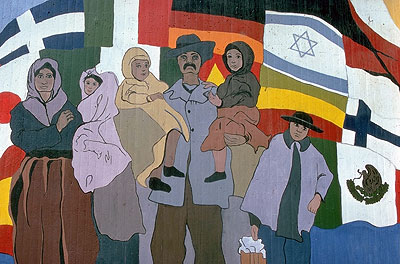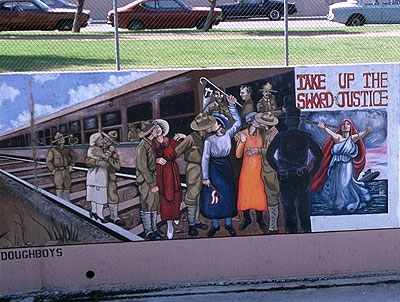 | The Longest Mural In The World |
The Great Wall of Los Angeles is one of Los Angelesí true cultural landmarks and one of the countryís most respected and largest monuments to inter-racial harmony. SPARCís first public art project and its true signature piece, the Great Wall is a landmark pictorial representation of the history of ethnic peoples of California from prehistoric times to the 1950ís, conceived by SPARCíS artistic director and founder Judith F. Baca. Begun in 1974 and completed over five summers, the Great Wall employed over 400 youth and their families from diverse social and economic backgrounds working with artists, oral historians, ethnologists, scholars, and hundreds of community members. |
Its half-mile length (2,754 ft) in the Tujunga Flood Control Channel of the San Fernando Valley with accompanying park and bike trail hosts thousands of visitors every year, providing a vibrant and lasting tribute to the working people of Californiaís who have truly shaped its history. In 2000 and 2001 SPARC received acknowledgement and support from the distinguished Ford Foundation Animating Democracy: The Role of Civic Dialogue in the Arts initiative and from the Rockefeller Foundation Partnerships Affirming Community Transformation initiative to continue work on the Great Wall; to hold civic dialogue sessions and ultimately design the remaining four decades of the century (1960, 1970, 1980 and 1990s). The muralís restoration, a critical need, and continuation with future panels produced by the next generation of children of the Great wall remains a vital on going program of SPARC. We are currently initiating a major fundraising campaign to restore, extend and create a full use park at the Great Wall thereby establishing the site as an international educational and cultural destination point. |
In 1975 when the Great Wall was still a dream, I never imagined it would lead me, the more than 400 young "Mural Makers" and the 35 other artists on my team through such a moving set of experiences. Nor could I have imagined that 27years from the date the first paint was applied to the wall that it would still be a work in progress.When I first saw the wall, I envisioned a long narrative of another history of California; one which included ethnic peoples, women and minorities who were so invisible in conventional text book accounts. The discovery of the history of California''s multi‑cultured peoples was a revelation to me as well as to the members of my teams. We learned each new decade of history in summer installments; the 20''s in 1978, the 30''s in 1980, the 40''s in 1981, and the 50''s in 1983. Each year our visions expanded as the images traveled down the wall. While our sense of our individual families'' places in history took form, we became family to one another. Working toward the achievement of a difficult common goal shifted our understandings of each other and most importantly of ourselves. |
By 1980 the mural, dubbed "The Great Wall" rather than its official name "The History of California," stretched more than a third of a mile and had consumed some 600 gallons of paint and 65,000 kid‑hours. With the completion of the decade of the Forties in September, 1981, the total length reached 2,085 feet while the number of young people who had worked on the mural rose to 185. In the summer of 1983, a new segment was painted, depicting the decade of the 1950''s. To date, the length of the Great Wall totals 2,754 feet, and the number of participating youths has reached over 400 |
The arrival of the Spanish explorer Portillo, who brought the first expedition from Mexico to L.A. in 1769, begins the third segment designed by Judith Baca. The figures in the clouds of smoke that rise from the Indian campfires represent the legendary Black Amazon Queen, Califia, whom Portillo expected to find and for whom California is named. Further on, riding a mule, Father Junipero Serra arrives. Founder of missions throughout California, he is depicted with the San Fernando mission behind him. Within a year after the arrival of the Spaniard, a large percentage of the Native American population of 150,000 inhabitants died of diseases to which they had no immunity that the White men brought. For this reason, the San Fernando Mission became known to the Indians as the "House of Death."Mexico governed California until 1843, the sword and the Bible marching hand in hand. The fourth segment, designed by Judith Hernandez, is dominated by the figure of a Spanish land baron, illustrating the "hacendados" who dominated early California. His serape is formed by the land and labor of the Indians which he has taken and used to build the hacienda toward which he looks and where an elegant wedding is taking place. The panel begins with soldiers who raise the Spanish flag and ends with the battle between the Mexican army and the U.S. cavalry for the control of California |
|
The Gold Rush era as designed by Ulysses Jenkins provides a Black‑American perspective on this period. It begins with the discovery of gold at Sutters'' Mill and the migration of Blacks, Mexicans and Indians as well as Whites by ship to California. Above the bay are portraits of Mifflin W. Gibbs, publisher of the first Black newspaper and Mary Ellen Pleasant, a civil rights activist who helped defend Blacks arraigned under the fugitive slave laws. The globe represents the world''s desire for the riches of the 49ers. Beside it stands William A. Leidesdorf, pilot of the first steamboat to arrive in San Francisco Bay, who later became a vice consul to Mexico. |
Meanwhile, in the state capital at Monterey, ex‑Southerners passed laws-WHITES ONLY‑which did not allow people of Mexican, Black or Chinese descent to make claims. Biddy Mason, an ex‑slave from Georgia who fought extradition under the fugitive slave laws and who became wealthy, was known for her charity and was a founder of the African Methodist Church in Los Angeles. Joaquin Murieta, a legendary Mexican Robin Hood, fights for the oppressed: The landless who "squat" on the state; the "hanging tree" victims of prejudice; and the Indians who are slaughtered with the coming of the "Iron Horse." |
The "Iron Horse" also brings a wave of Chinese immigration. Designed by Gary Takamoto, the Chinese segment shows the workers on the transcontinental railroad, which was built largely by Chinese labor. The faces which appear in the smoke of the locomotive honor those who died in the course of this mammoth undertaking. A surge of racism that accompanied the Chinese immigration led to the so‑called "Chinese Massacre " when vigilantes hung 11 Chinese in a downtown Los Angeles street |
1890 L.A. Mountains to the Shore. The typical shops and buildings of turn‑of‑the‑century L.A. are depicted in this lyrical segment. |
The first summer''s work concludes with an homage to the new wave of immigrants and their labor, so important in the development of this region. Designed by Isabel Castro, the section begins with an image showing these new arrivals in a wave of flags which indicated their varied origins. The segment continues with the invention of the car and airplane, which shaped the development of 20th century California |
Emphasis in this section is on women''s role in the war experience. The "Edisonís Mexican‑American heritage is symbolized by the Chichimeca corn goddess who whispers the secrets of the ancient builders and inventors in his ear. In one hand he holds a light bulb which lights the world, in the other a movie camera symbolizing the modern communications industry. Hollywood is celebrated in the final image of William S. Hart, star of the first cowboy movie ever made, "The Great Train Robbery." The scene shows the movie actors on the set and also in the camera viewer |
In 1974, the Army Corps of Engineers contacted Judith F. Baca about the possibility of creating a mural in the flood control channel as part of a beautification project that included a mini‑park and bicycle path. Two years later the alchemy of converting concrete eyesore into community treasure began.
Production of the Great Wall has involved the support of many government agencies, community organizations, businesses, corporations, foundations, and individuals. This support has taken the form of cash contributions, donations of supplies and equipment, and offered services. In the first several years, SPARC received a great deal of support for the project from governmental juvenile justice funding sources. In recent years, more private sector funding has made the Great Wall possible. Throughout the years, assistance has come from the Summer Youth Employment Program, the Army Corps of Engineers, and the Flood Control District.
A mural of California history
The Great Wall of Los Angeles
Wall

